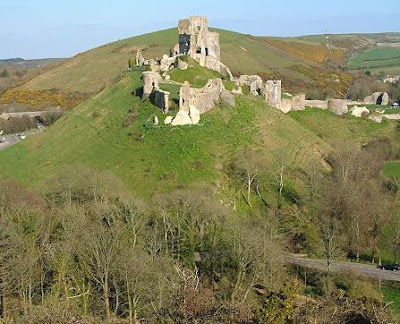The castle was established by William the Conqueror as a wooden motte-and-bailey, but not long afterward it received an outer wall of stone. The stone keep was built by Henry I, completed in 1105.
A plan of the castle made in 1586.
The castle was not besieged until 1645, 550 years after it was built. Dorset was Parliamentary territory, but the castle was held by royalist Lady Mary Bankes. First the Roundheads tried to seize the castle by a ruse, infiltrating a party returning from a hunt, but they were found out and foiled. Then they laid siege, but even though Lady Bankes had only 80 men, she held them off for six weeks until relief arrived. But the castle was besieged again a few months later, and this time it was betrayed by one of its officers and taken. Lady Banks was allowed to depart unharmed. Above is a 19th-century copy of a now lost 17th century portrait of the steadfast Lady Bankes.
After taking the castle the Parliamentarians "slighted" it, that is, blew up key parts of the fortifications in ways that made it hard to defend. Abandoned, it decayed into today's ruin.
In 2008 a badly worn carving of a pelican was discovered in the keep. In the Middle Ages the pelican was considered a symbol for Christ, because it was thought to feed its babies from its own bloody breast. Above, the carving as it is today and a modern recreation.










No comments:
Post a Comment